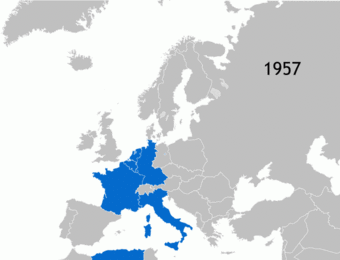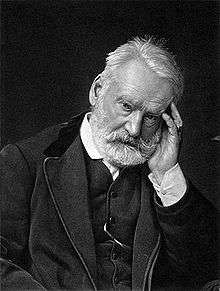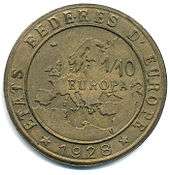Ideas of European unity before 1945
Part of a series on the |
||||||||||||||||||||||||
|---|---|---|---|---|---|---|---|---|---|---|---|---|---|---|---|---|---|---|---|---|---|---|---|---|
| History of the European Union |
||||||||||||||||||||||||
 | ||||||||||||||||||||||||
|
Organisation
|
||||||||||||||||||||||||
|
||||||||||||||||||||||||
|
| ||||||||||||||||||||||||
The idea of European unity is a historically recent concept.
The name Europe originally referred to only the south-eastern part of the continent, in the same way that Asia originally referred to western Anatolia, and Africa referred to the northern portion of the African continent. It was the Greek civilisation that first used these names in their modern senses.
The first proposal for peacefully unifying Europe against a common enemy emerged after the Fall of Constantinople to the Turks in 1453. George of Podebrady, a Hussite king of Bohemia, proposed in 1464 a union of European, Christian nations against the Turks.[1] However, his proposal was based on the nations' shared religious ideology, and there is no evidence that he viewed their common geographic location as particularly significant.
The Frankish Empire of Charlemagne and the Holy Roman Empire united large areas of Germany, Italy, and France under a loose administration for hundreds of years without articulating an idea of European unity. However, the concept of a Europe made up of those parts of the continent occupied by Germanic peoples had become common by the 19th century, as is evidenced in Russian philosopher Danilevsky's Russia and Europe. The idea of Germany and Europe being coterminous was taken to its fateful conclusion by Adolf Hitler.
Holy Roman Empire
Kikuchi Yoshio (菊池良生) of Meiji University suggested that the notion of Holy Roman Empire as a federal political entity influenced the later structural ideas of the European Union.[2]
Pre-Napoleon
In 1693, William Penn looked at the devastation of war in Europe and wrote of a "European dyet, or parliament", to prevent further war, without further defining how such an institution would fit into the political reality of Europe at the time.[3]
In 1728, Abbot Charles de Saint-Pierre proposed the creation of a European league of 18 sovereign states, with common treasury, no borders and an economic union. After the American War of Independence the vision of a United States of Europe, similar to the United States of America, was shared by a few prominent Europeans, notably the Marquis de Lafayette and Tadeusz Kościuszko.
Some suggestion of a European union can be inferred from Immanuel Kant's 1795 proposal for an "eternal peace congress".
19th century
In the 1800s, customs union under Napoleon Bonaparte's Continental system was promulgated in November 1806 as an embargo of British goods in the interests of French hegemony. Felix Markham notes how during a conversation on St. Helena, Napoleon remarked, "Europe thus divided into nationalities freely formed and free internally, peace between States would have become easier: the United States of Europe would become a possibility."[4]
The French socialists Saint-Simon and Augustin Thierry would in 1814 write the essay De la réorganisation de la société européenne, already conjuring up some form of parliamentary European federation.

In the conservative reaction after Napoleon's defeat in 1815, the German Confederation (German: Deutscher Bund) was established as a loose association of thirty-eight sovereign German states formed by the Congress of Vienna. Napoleon had swept away the Holy Roman Empire and simplified the map of Germany. In 1834, the Zollverein ("customs union") was formed among the states of the Confederation, to create better trade flow and reduce internal competition. An extension of this customs union may have been become the model for a unified Europe, as alluded to by Fritz Fischer in Germany's Aims in the First World War. The then current ideas of geopolitics and a Mitteleuropa were also influential in providing an intellectual framework for European Union in Germany.
United States of Europe was also the name of the concept presented by Wojciech Jastrzębowski in About eternal peace between the nations, published 31 May 1831. The project consisted of 77 articles. The envisioned United States of Europe was to be an international organisation rather than a superstate.
Italian writer and politician Giuseppe Mazzini called for the creation of a federation of European republics in 1843. This set the stage for perhaps the best known early proposal for peaceful unification, through cooperation and equality of membership, made by the pacifist Victor Hugo in 1847. Hugo used the term United States of Europe (French: États-Unis d'Europe) during a speech at the International Peace Congress, organised by Mazzini, held in Paris in 1849. Hugo favoured the creation of "a supreme, sovereign senate, which will be to Europe what parliament is to England" and said "A day will come when all nations on our continent will form a European brotherhood ... A day will come when we shall see ... the United States of America and the United States of Europe face to face, reaching out for each other across the seas." However, he was laughed out of the hall, yet returned to his idea again in 1851. Victor Hugo planted a tree in the grounds of his residence on the Island of Guernsey he was noted in saying that when this tree matured the United States of Europe would have come into being. This tree to this day is still growing happily in the gardens of Maison de Hauteville, St. Peter Port, Guernsey, Victor Hugo's residence during his exile from France.
The Italian philosopher Carlo Cattaneo wrote "The ocean is rough and whirling, and the currents go to two possible endings: the autocrat, or the United States of Europe". In 1867 Giuseppe Garibaldi, and John Stuart Mill joined Victor Hugo at a congress of the League of Peace and Freedom in Geneva. Here the anarchist Mikhail Bakunin stated "That in order to achieve the triumph of liberty, justice and peace in the international relations of Europe, and to render civil war impossible among the various peoples which make up the European family, only a single course lies open: to constitute the United States of Europe". The French National Assembly, also called for a United States of Europe on 1 March 1871.
As part of 19th c. concerns about an ailing Europe and the threat posed by the Mahdi, the Polish writer, Theodore de Korwin Szymanowski's original contribution was to focus not on nationalism, sovereignty and federation, but foremost on economics, statistics, monetary policy and parliamentary reform. His L'Avenir économique, politique et social en Europe - The Future of Europe in Economic, Political and Social Terms - published in Paris in 1888[5] was in effect, a blueprint for a unified Europe with a customs union, a central statistical office, a central bank and a single currency.
After the First World War

Following the catastrophe of the First World War, some thinkers and visionaries again began to float the idea of a politically unified Europe. In 1923, the Austrian Count Richard Coudenhove-Kalergi founded the Pan-Europa movement and hosted the First Paneuropean Congress, held in Vienna in 1926. The aim was for a specifically Christian, and by implication Roman Catholic, Europe. In contrast Trotsky raised the slogan "For a Soviet United States of Europe" in 1923, for a non-Christian but communist Europe.
In 1929, Aristide Briand, French prime minister, gave a speech in the presence of the League of Nations Assembly in which he proposed the idea of a federation of European nations based on solidarity and in the pursuit of economic prosperity and political and social co-operation. Many eminent economists, among them John Maynard Keynes, supported this view. At the League's request Briand presented a Memorandum on the organisation of a system of European Federal Union in 1930.
In 1931 the French politician Édouard Herriot published the book The United States of Europe. The British civil servant Arthur Salter published a book of the same name in 1933.
Between the two world wars, the Polish statesman Józef Piłsudski envisaged the idea of a European federation that he called Międzymorze ("Intersea" or "Between-seas"), known in English as Intermarum, which was a Polish-oriented version of Mitteleuropa.
The Great Depression, the rise of fascism and communism and subsequently World War II prevented the inter war movements from gaining further support.
Impact of the Second World War
In Britain the group known as Federal Union was launched in November 1938, and began advocating a Federal Union of Europe as a post-war aim. Its papers and arguments became well known among resistants to fascism across Europe and contributed to their thinking of how to rebuild Europe after the war.
Among those who were early advocates of a union of European nations was Hungarian Prime Minister Pál Teleki. Hungary had lost over two-thirds of its territory at the end of World War I in the 1920 Treaty of Trianon. In early 1941 during the Second World War, he was striving to keep Hungary autonomous. Internally, he tried to satisfy national pride which demanded a restoration of the lost territories, which Germany had supported in the First Vienna Award of 1938 and the Second Vienna Award of 1940. Externally, he was striving to preserve his country's military and economic independence in the face of Germany's coercive pressure to join in their invasion of Yugoslavia. In the book, Transylvania. The Land Beyond the Forest Louis C. Cornish[6][7] described how Teleki, under constant surveillance by the German Gestapo during 1941, sent a secret communication to contacts in America.[8]
He foresaw clearly the complete defeat of Nazi Germany, and the European chaos that would result from the war. He believed that no future was conceivable for any of the minor nations in Central and Eastern Europe if they tried to continue to live their isolated national lives. He asked his friends in America to help them establish a federal system, to federate. This alone could secure for them the two major assets of national life: first, political and military security, and, second, economic prosperity. Hungary, he emphasized, stood ready to join in such collaboration, provided it was firmly based on the complete equality of all the members states.[8]
Journalist Dorothy Thompson in 1941 supported the statement of others. "I took from Count Teleki's office a monograph which he had written upon the structure of European nations. A distinguished geographer, he was developing a plan for regional federation, based upon geographical and economic realities."[8] Teleki received no response from the Americans to his ideas and when German troops moved through Hungary on 2–3 April 1941 during the invasion of Yugoslavia, he committed suicide.
In 1943, the German ministers Joachim von Ribbentrop and Cecil von Renthe-Fink eventually proposed the creation of a "European confederacy" as part of a New Order on the continent. The proposal, which attracted little support from the Nazi leadership, would have had a single currency, a central bank in Berlin, a regional principle, a labour policy and economic and trading agreements but left all states clearly subordinated to Nazi Germany.[9] The countries proposed for inclusion were Germany, Italy, France, Denmark, Norway, Finland, Slovakia, Hungary, Bulgaria, Romania, Croatia, Serbia, Greece and Spain. Such a German-led Europe, it was hoped, would serve as a strong alternative to the Communist Soviet Union and the United States.[9] It is worth noting that the Benelux countries are omitted from the list of proposed countries, as their future integration into the German Reich had already been decided.
The later Foreign Minister Arthur Seyss-Inquart said: "The new Europe of solidarity and co-operation among all its people will find rapidly increasing prosperity once national economic boundaries are removed", while the Vichy French Minister Jacques Benoist-Méchin said that France had to "abandon nationalism and take place in the European community with honour." These pan-European illusions from the early 1940s were never realised because of Germany's defeat. Neither Hitler, nor many of his leading hierarchs such as Goebbels, had the slightest intention of compromising absolute German hegemony through the creation of a European confederation. Although this fact has been used to insinuate the charge of fascism in the EU, the idea is much older than the Nazis, foreseen by John Maynard Keynes, and later Winston Churchill and various anti-Nazi resistance movements.[10]
"A one sided Prussian militarism must never again be allowed to assume power. Only in large-scale cooperation among the nations of Europe can the ground be prepared for reconstruction...Freedom of speech, freedom of religion, the protection of individual citizens from the arbitrary will of criminal regimes of violence — these will be the bases of the New Europe."
Aufruf an alle Deutsche! pamphlet by the White Rose, January 1943
One of the most influential figures in this process was Altiero Spinelli, co-author with Ernesto Rossi of the "Ventotene Manifesto" entitled "Towards a Free and United Europe" and smuggled out of their internment camp – the island of Ventotene – as early as 1941, well before the outcome of the war was safely predictable, and widely circulated in the resistance movements. Spinelli, Rossi and some 20 others established, as soon as they were able to leave their internment camp, the Movimento Federalista Europeo (MFE). The founding meeting, secretly held in Milan on the 27/28 August 1943, adopted a "political thesis" which, inter alia, stated: "if a post war order is established in which each State retains its complete national sovereignty, the basis for a Third World War would still exist even after the Nazi attempt to establish the domination of the German race in Europe has been frustrated".
In 1943, Jean Monnet a member of the National Liberation Committee of the Free French government in exile in Algiers, and regarded by many as the future architect of European unity, is recorded as declaring to the committee: "There will be no peace in Europe, if the states are reconstituted on the basis of national sovereignty ... The countries of Europe are too small to guarantee their peoples the necessary prosperity and social development. The European states must constitute themselves into a federation ..."
See also
- Federal Europe
- Pan-European identity
- European integration
- History of the European Union
- Universal Monarchy
References
- ↑ Wen, Shuangge (2013). Shareholder Primacy and Corporate Governance Legal Aspects, Practices and Future Directions. Hoboken: Taylor and Francis. p. 109. ISBN 9781136019845.
- ↑ Kikuchi (菊池), Yoshio (良生) (19 July 2003). 神聖ローマ帝国. p. 264. ISBN 978-4-06-149673-6. Retrieved 2011-02-23.
- ↑ Penn, William; Andrew R. Murphy (2002). "The Political Writings of William Penn". Liberty Fund. Retrieved 21 August 2012.
- ↑ Felix Markham, Napoleon (New York: Penguin Books USA Inc., 1966), 257 as quoted in Matthew Zarzeczny, Napoleon's European Union: The Grand Empire of the United States of Europe (Kent State University Master's thesis), 2.
- ↑ Théodore de Korwin Szymanowski, L’avenir économique, social et politique en Europe, Ed. H. Marot, Paris 1888, http://www.msz.gov.pl/pl/ministerstwo/publikacje/biblioteka_jednosci_europejskiej/przyszlosc_europy_w_zakresie_gospodarczym__spolecznym_i_politycznym__l_avenir_economique__social___politique_en_europe, dual text in French and Polish, with a postface by Prof. Radosław Żurowski vel Grajewski
- ↑ Transylvania. The Land Beyond the Forest. Dorrance & Company. 1947. ASIN B000WUMLQO.
- ↑ Pal Teleki (1923). The Evolution of Hungary and its place in European history (Central and East European series).
- 1 2 3 Francis S. Wagner (ed.) (1970). Toward a New Central Europe: A Symposium on the Problems of the Danubian Nations. Astor Park, Florida: Danubian Press, Inc.
- 1 2 Lipgens, Walter (1985). Documents on the History of European Integration: Continental Plans for European Union 1939–1945. Walter de Gruyter. ISBN 3-11-009724-9.
- ↑ Mark Mazower, Dark Continent, 1.30
Bibliography
- >Pasture, Patrick (2015). Imagining European unity since 1000 AD. New York: Palgrave Macmillan. ISBN 9781137480460.
- Stirk, P.M.R., ed. (1989). European Unity in Context: The Interwar Period (1st ed.). London: Pinter Publishers. ISBN 9780861879878.
- Smith, M.L.; Stirk, P.M.R., eds. (1990). Making The New Europe: European Unity and the Second World War (1st UK ed.). London: Pinter Publishers. ISBN 0-86187-777-2.